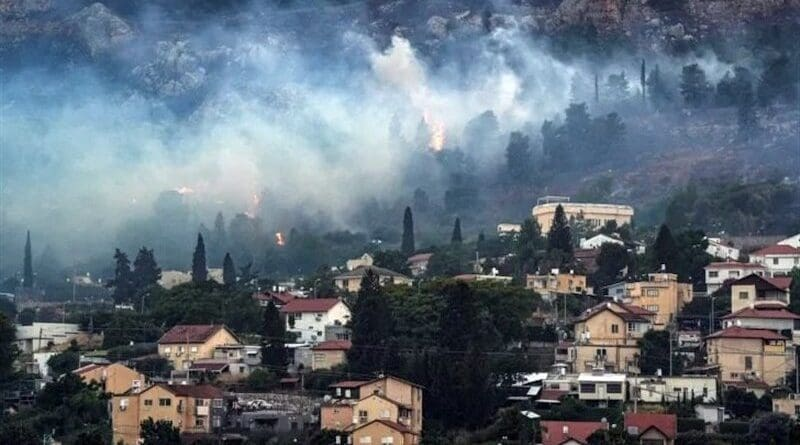
Hezbollah said that it launched rockets and weaponized drones at several Israeli military sites in a coordinated attack on Thursday.
An Israeli strike that killed a senior Hezbollah field commander led to the retaliatory attacks, according to Hezbollah.
Israeli media outlets said that Hezbollah fired “150 rockets in half an hour,” adding that “over 30 drones were launched toward the Galilee and the Golan.”
Sirens sounded for hours in Israeli settlements, including Safad, Baram, Avivim, Yir’on, and Kiryat Shmona and its surroundings, as well as the surroundings of Meron.
Black smoke covered the targeted Israeli region, as seen in footage shared by Israeli activists on social media.
Hezbollah vowed on Wednesday to avenge the killing of Taleb Sami Abdallah, known as “Abu Taleb,” a senior Hezbollah field commander who was killed in an Israeli raid along with three other field commanders last Tuesday.
The victims were about to hold a security meeting in a residential building in the Lebanese southern village of Jouaiyya when the raid took place.
The Israeli army radio described Thursday’s attack as “the largest daily attack since the outset of the confrontations last October,” adding that “215 rocket-propelled grenades were launched.”
Israeli media outlets said that “fire erupted in 15 locations in the Golan and the Galilee due to the rocket salvo.”
The Israeli army media outlets reported “direct damage to a building in the Yiron Kibbutz in the Galilee.”
The media added that 50 missiles were fired from Lebanon toward Katzrin in southern Golan and its surroundings, resulting in several casualties.
The Magen David Adom rescue service said that “two people were injured in Katzrin due to the heavy shelling.”
According to Hezbollah’s statements, and as reported by the Israeli Kan 11 TV channel, the rocket attack carried out by the group on Wednesday caused “fires in many areas in northern Israel,” adding that “25 fire brigades worked with further assistance on preventing the expansion of fires.”
Israeli police reported on Thursday that “explosives experts are dealing with sites where rockets fell in the Golan and Upper Galilee.”
Hezbollah announced that six Israeli barracks and military sites were targeted in a joint attack using rockets and drones.
The sites targeted with Katyusha and Falaq rockets were the Al-Zaoura barracks, Kaila barracks, Yoav barracks, Katsavia base, Nafah base, and the Sahel Battalion in Beit Hillel.
Simultaneously, the group launched an aerial attack with several assault drones on the David base (headquarters of the northern region command), Mishar base (headquarters of the central intelligence unit of the north of region charged with assassination missions), and Katsavia barracks (headquarters of the 7th Armored Brigade of the Golan Division 210), hitting their targets.
Earlier in the morning, Hezbollah announced “targeting the Al-Raheb site with heavy machine guns and artillery shells, hitting it directly.”
On the other hand, Israeli artillery and warplanes launched airstrikes on Lebanese border towns, from which Israel believes Hezbollah rockets were launched.
They hit the outskirts of Marjayoun toward Dibbine, Jabal Al-Rihane, and the outskirts of the town of Shebaa, and buildings in Aita Al-Shaab, which (Israel) claimed were “military (buildings) belonging to Hezbollah.”
Israeli warplanes also raided the northern outskirts of the town of Jdeidet Marjayoun, Aainata, the area between Aitaroun and Bint Jbeil, and the outskirts of the town of Haris.
Israeli attacks — using internationally banned phosphorus bombs — targeted the outskirts of the town of Deir Siriane for the first time since the confrontations began, as well as the town of Yohmor Al-Shaqif.
The Israeli attacks caused fires to break out in the forests on the outskirts of Jdeidet Marjayoun.
Teams from the Lebanese Red Cross, the Islamic Health Authority affiliated with Hezbollah, and Lebanese Civil Defense vehicles, rushed to extinguish the fires in cooperation with townspeople. There were no casualties.
Reports from the town of Rmeish reported fire spreading into Khallet Al-Wahle, and the municipality appealed to UNIFIL to intervene.
This is the second time that the town of Jdeidet Marjayoun has been targeted since hostilities began in the border area 250 days ago.
It was previously targeted by a raid on a center of the Amal movement in the town’s center several months ago, resulting in the deaths of three of its members.
Recently, both Hezbollah and the Israeli army have used fire as a hostile tactic.
The Israeli military uses incendiary shells, including phosphorus, to bomb Lebanese towns and forests.
At the same time, Hezbollah recently burned “about 3,500 dunams of the Berea and Meron forests alone,” according to the Israeli media.
Israeli warplanes broke the sound barrier over the eastern sector, reaching the Jezzine area at a low altitude.
Hezbollah’s confrontations with Israel since Oct. 8, 2023, in support of the “Al-Aqsa Flood” operation conducted by Hamas in the Gaza Strip, have resulted in the deaths of 467 people in Lebanon.
